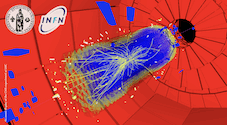Dr
Monica Scaringella
(Univeristà di Firenze)
To harvest the maximum physics potential of the LHC, it is foreseen to significantly increase the luminosity by upgrading towards the HL-LHC (High Luminosity LHC). This will mean unprecedented radiation levels, exceeding the LHC fluences tenfold. Due to radiation damage to the silicon sensors presently used, the physics experiments will require new tracking detectors. Within the CERN RD50 Collaboration, a massive R&D programme is underway across experimental boundaries to develop HL-LHC silicon sensors. One research topic is the connection between the macroscopic sensor properties such as radiation-induced increase of leakage current, doping concentration and trapping, and the microscopic properties. We also study sensors made from p-type silicon bulk, which have a superior radiation hardness as they collect electrons instead of holes, exploiting the lower trapping probability of the electrons. A further area of activity is the development of advanced sensor types like 3D detectors designed for the extreme radiation levels expected for the vertexing layers. We will present the latest results of several detector technologies and silicon materials at radiation levels corresponding to HL-LHC fluences. Based on these results, we will give recommendations for the silicon detectors to be used for tracking systems in the LHC upgrades.
Summary
This presentation will cover the most recent RD50 results in a number of areas:
We will show the performance of 3D detectors before and after HL-LHC irradiation, demonstrating that the 3D technology has become a reliable candidate for LHC-Upgrades.
Electric field measurements in heavily irradiated planar detectors will be presented, obtained in an edge-TCT setup with an infrared laser shining onto the polished edge of silicon detectors parallel to the detector surface. The field measurements are showing surprisingly high electric fields in the range of 0.5 V per micrometer in the undepleted silicon. The existence of this strong field can help to explain the unexpectedly good performance of planar silicon detectors after more than 10E16 Neutron-equivalent per cm2.
Observations of charge multiplication effects at very high bias voltages in a number of detectors will be reported. We will also describe a set of dedicated detectors designed in order to better understand the charge multiplication mechanism, thought to originate from avalanche multiplication in the high-field region of the detectors.

